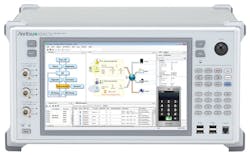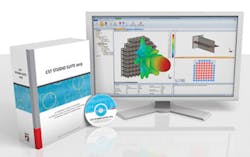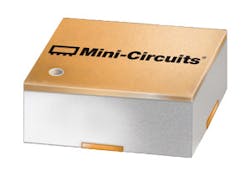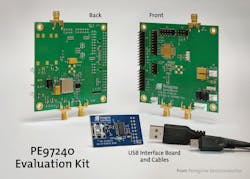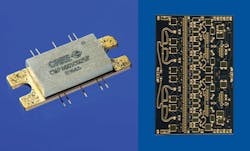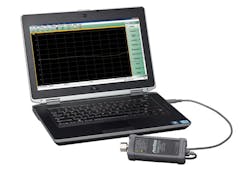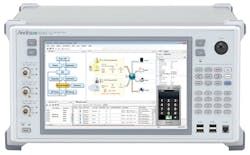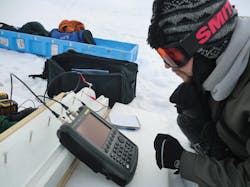Cavalcade of Cutting-Edge Products Invades 2015 IMS
The 2015 IEEE IMS is, of course, an important educational event for many, featuring an excellent collection of technical presentations and focused technical meetings like the Automatic RF Techniques Group (ARFTG). But a great deal of the education takes place right on the exhibition floor with every stop—at every booth. For those working company booths on the floor, there’s little more gratifying (save for a product order taken at the booth) than a visitor stopping at the booth and wanting to know more about the company and its products. It offers a chance to exchange business cards and make contacts for future business, and an avenue toward learning more about a company and those products on display.
A walk through IEEE IMS Exhibition can usually bring visitors up to speed on any of the different technologies driving this industry. However, over the last few decades, software developers have taken an increasingly prominent position on the show floor, likely because their simulation and analysis tools play an increasingly prominent role in the working lives of RF/microwave engineers. Modern computer-aided-engineering (CAE) simulation software impacts almost every device and circuit technology, and engineers across the industry use the close match between simulated and measured results as the reassurance that a circuit design is sound and reliable. Among other things, the 2015 IEEE IMS Exhibition offers an opportunity to try out the latest design software tools and perhaps grab one or two free copies of demonstration software to learn more about programs that may not be so familiar.
The exhibition area is open for slightly less than three days, and visitors can easily spend all of their time just scouring the sections of the show floor and the companies devoted to CAE software or to test equipment. This article presents a sampling of what to expect from some of the companies on the show floor, but hardly covers even a significant portion of what will be on hand in the exhibition area. As always, to learn more, contact a company of interest. For those fortunate enough to make the trip to Phoenix, Ariz. in May, value the time at each booth and spend it wisely.
Simulation Permutations
Often, such product exhibitions open up possibilities to see how things work, such as simulation software and test equipment. The exhibition booths will particularly be well stocked with computer simulation software, including some of the most sophisticated electromagnetic (EM) simulation tools.
For instance, the event offers the opportunity to spend time with the likes of Dr. Jim Rautio, founder of Sonnet Software (Booth 2640) and developer of the firm’s famed Sonnet Suites of EM simulation software tools. These three-dimensional (3D) planar EM simulation programs analyze the fields around high-frequency circuits (e.g., microstrip and stripline) and predict the EM fields that will occur around different structures (e.g., filters and antennas) and different circuit junctions. They provide engineers with a means to predict the effects of using direct materials with different dielectric constants and loss characteristics at different frequencies before having to fabricate a number of prototype circuits.
Though considered standalone tools, the Sonnet Suites are also integrated with many other high-frequency CAE simulation programs, including the Advanced Design System (ADS) from Keysight Technologies (Booth 739), Cadence Virtuoso from Cadence Design Systems (Booth 2832), the CST Studio Suite (Fig. 1) from CST of America (Booth 3244), MATLAB from MathWorks (Booth 107), and the AWR Microwave Office design tools from Applied Wave Research and parent company National Instruments (Booth 2431). Each of these software tools will be available for demonstration at their respective booths, with the benefit of knowledgeable users on hand to answer questions.
For those who may be intimidated by the cost of electronic-design-automation (EDA) software, Sonnet Software also offers Sonnet Lite software for free download from the company’s website. This is a limited version of the Sonnet Suites, which is quite useful for taking a “first look” at certain designs and then deciding whether to make the investment in the full-scale version of the software. Across the show floor, numerous other vendors offer affordable software solutions with or without free trial versions. For example, Intercept Technology (Booth 948) provides design tools that helps create practical schematic diagrams as well as printed-circuit-board (PCB) layouts. In any case, for those exploring the 2015 IMS for high-frequency software tools, a visit to Sonnet Software makes a good first stop before delving into system-level EDA tools.
Not far from Sonnet, ANSYS (Booth 2036) will show examples of its different CAE tools, including its own 3D EM simulation software, the High-Frequency Structure Simulator (HFSS) software. This full-wave EM simulation tool has long been used to model not only RF/microwave circuits, but high-speed digital circuits as well. The software provides advanced solver approaches based on finite-element (FE) and integral-equation solutions, and includes a linear circuit simulator to help designers create circuit transitions such as input and output matching circuits in amplifiers and other active circuits.
On the other side of the exhibition hall, at Keysight’s (formerly Agilent Technologies) Booth 739, visitors can learn about the latest trend in EDA software tools— products such as Keysight’s Advanced Design System (ADS) and SystemVue system-level software tools. These work seamlessly with EM simulators and component-level circuit simulators to provide integrated modeling tools for high-frequency analog and high-speed digital circuit and system designers.
This file type includes high resolution graphics and schematics when applicable.
Building Blocks
Visitors to the 2015 IMS Exhibition can likely fill bags with free samples and literature, and in the process gain an enormous education on the latest technologies driving the RF/microwave industry. The real problem is where to start and how long to spend at each booth, considering there’s only a “mere” 2.5 days available for exploration. One possible way to kick things off is to simply work from the ground up and start with building-block components, such as PCB materials.
Arlon Materials For Electronics (Booth 531), which as of January became part of Rogers Corp. (Booth 3640), will show its variety of high-performance PCB materials, including PTFE-based circuit materials for high-frequency circuits. For example, its CLTE series of woven-glass/PTFE materials feature a dielectric constant of 2.94 in the z-direction at 10 GHz with excellent stability versus temperature for phase-sensitive applications (e.g., radar systems). Well suited for temperature-sensitive systems like avionics, electronic warfare (EW), and communications applications, these materials achieve outstanding coefficient of thermal expansion (CTE) performance, maintaining consistent circuit performance even over wide operating temperature ranges.
The firm will also show its TC series of thermally conductive materials, available with somewhat higher dielectric-constant values such as 6.15 and 8.50 in the z-axis at 10 GHz. These materials were developed for applications plagued by heat-related issues, such as amplifiers and transmit antennas. Excellent thermal conductivity is needed to avoid “hotspots” on a high-power RF/microwave circuit.
Not far from Arlon, at Booth 231, Taconic will provide samples of its different circuit materials, including woven-glass-reinforced PTFE laminates and ceramic-filled PTDE laminates. In addition, the company will unveil its new TacLam PLUS microwave laminates for low-loss circuits using single- and multiple-layer designs. These are nonwoven, ceramic-loaded PTFE-based materials with dielectric constant of 2.1 at 10 GHz and low loss tangent of only 0.004 at 10 GHz. With a metal backing, such as 1-mm-thick copper, the material maintains excellent dimensional stability.
Rogers Corp., Arlon’s new parent company, will also be on hand across the show floor to update visitors on its many different circuit materials, including the popular RO4350B and RO4003C. These are proprietary woven-glass-reinforced hydrocarbon/ceramic materials with electrical performance close to PTFE/woven-glass circuit materials. They also feature the ease of manufacturability of epoxy/glass, with no special production treatments or processes required to create RF/microwave circuit boards. RO4003 exhibits a dielectric constant of 3.38 at 10 GHz and RO4350B has a dielectric constant of 3.48. Both hold those values over temperature and frequency to provide stable circuit performance under a wide range of environmental conditions.
Members of the Dielectric Laboratories Inc. (DLI) arm of Knowles Capacitors will be on hand at booth 129 to show its latest dielectric material, rated for high-voltage use through +50 V dc. The “UX” material, which is space-qualified to MIL-PRF-38534 Class K requirements, supports higher-valued capacitors in smaller-sized housings. The material can be specified across DLI’s broad range of thin-film capacitors, including its Di-Caps and Border Caps. The UX material, which will be available in capacitors with a capacitance range of 51 to 10,000 pF, suits applications such as amplifier stabilization, energy storage, dc blocking, and broadband decoupling.
Coilcraft (Booth 1929) will be on hand to advise visitors on its many inductors and other magnetic components, as well as the latest version of the Coilcraft LC Filter Designer software for designing low-pass elliptic filters. The software enables S-parameter analysis in logarithmic or linear scales; users can work in minimum-capacitor or minimum-inductor circuit topologies for a given set of filter design goals. The software, available for free download from the firm’s website, works with actual Coilcraft inductance values. Also on its website are a number of different tools, including the RF Inductor Finder to help quickly find inductors using operating frequency and/or inductance as search values.
Among its assortment of passive components, EMC Technology (Booth 2236) will showcase its low-loss HybriX hybrid couplers. These models, optimized for applications from 0.5 to 3.5 GHz, are well suited for wireless communications applications. For example, model WH1727F exhibits insertion loss of only 0.1 dB from 1700 to 2700 MHz, with 30-dB isolation between ports in a compact housing. In addition to their low loss, the couplers feature high power-combining efficiency with excellent amplitude and phase balance. The firm will also exhibit its Thermopad temperature-variable attenuators. These devices require no bias, but can be used for attenuation purposes where different responses are needed for different temperatures.
Planar Monolithics Industries will be on hand with an assortment of its active and passive components, including amplifiers and equalizers. For instance, the EQL-17D6G21D6G-4DB-292MF passive equalizer, targeting 17.6- to 21.6-GHz applications, has a -4-dB slope with frequency and ±0.5-dB linearity. It can handle input power levels to 0.5 W CW (+27 dBm). Supplied with 2.92-mm connectors, it measures just 1.10 × 0.67 × 0.22 in.
The company will also show amplifiers, such as its model PEC-30-2R04R0-1R5-21-8V-SFF-HS low-noise amplifier (LNA) with typical noise figure of 1.5 dB or less from 2 to 4 GHz. The amplifier comes with female SMA connectors in an EMI-shielded housing. It features better than 30-dB gain across its bandwidth with +21-dBm output 1-dB compression point. The LNA draws 380-mA maximum current from a +8-V dc supply.
Armed with information on some of the latest circuit materials, visitors may be ready to audition some of the many active and passive components to be found on the 2015 IMS Exhibition show floor. Perhaps no greater assortment of components will be found than at the site for Mini-Circuits (Booth 3331). A long-time supplier of active and passive components, the company has lately grown stronger in its development of test-and-measurement equipment. Mini-Circuits will have examples of its many different product lines at the exhibition, including an array of surface-mount-technology (SMT) components. Among them are some of the most broadband surface-mount components in the industry, such as the RCAT Series of fixed attenuators. They provide accurate attenuation levels across a wide bandwidth of dc to 20 GHz in attenuation values from 0 to 30 dB. Though measuring just 2.25 × 2.25 × 1.1 mm (Fig. 2), these monolithic attenuators can handle power levels to 2 W.
Surface-mount components represent just one of Mini-Circuits’ product lines, though. The firm is sure to show examples of its various coaxial and even waveguide components and assemblies. The HPA-272+, for example, is a much larger component than most IMS visitors will have in mind when thinking of the company’s products. This rack-mount amplifier, rated for 100-W output power from 700 to 2700 MHz, suits a variety of test applications, including electromagnetic-interference (EMI) testing. Replete with a self-contained 110/220-V ac power supply, the internally cooled amplifier provides 48-dB gain across its frequency range, with gain flatness of ±1.7 dB. It comes in a standard 19-in. rack-mount enclosure.
These larger products for Mini-Circuits are perhaps best embodied by the firm’s expansion into test equipment and measurement solutions through 18 GHz, including the rack-mount amplifiers, frequency counters, switch matrices, power sensors, and signal generators. Visitors to the booth will see the near-emergence of a secondary test-and-measurement company, with many practical measurement solutions.
For example, model SSG-6400HS is a USB-controlled synthesized signal generator in a compact housing measuring just 11.0 × 8.5 × 2.15 in. It tunes from 250 kHz to 6400 MHz with 0.01-Hz resolution and frequency tuning speed of 100 μs. It controls output-power levels from -75 to +14 dBm with power-level resolution of 0.01 dB. Despite the low cost, the signal generator provides a wide range of modulation formats and is spectrally clean, with phase noise of -133 dBc/Hz offset 10 kHz from a 1-GHz carrier.
In terms of generating signals, the IMS Exhibition will provide a wealth of sources for oscillators of every kind, from stable, fixed crystal oscillators to variable-frequency tunable varieties operating well through the microwave and millimeter-wave frequency ranges. At Booth 117, Synergy Microwave Corp. will demonstrate some of the results of its latest application-specific-integrated-circuit (ASIC) technology for low-noise microwave signal generation (see “Novel ASIC Helps Sources Silence Noise”). The company has long been a supplier of tunable oscillators and frequency synthesizers, and the latest phase-locked source designs feature low phase-noise levels from 100 MHz to 15 GHz, packed in miniature 2.25- × 2.25-in. module housings or 1.0- × 1.25-in. SMT packages.
The new ASIC works with reference frequencies, ranging from 1 MHz to 2.2 GHz, in single- and dual-loop source configurations. In addition to the low phase noise, the phase-locked sources also achieve fast frequency switching speeds, with frequency settling times of less than 100 μs.
In addition to its wide range of source products, Synergy Microwave will display examples of its different component lines, including attenuators, couplers, filters, mixers, and power dividers/combiners. Like the RF/microwave sources, these components come in a variety of package styles, including SMT and coaxial packages. As an example, model CLK-6000 is a double-balanced mixer in a package with connectors. It operates with a local oscillator (LO) and RF range to 6000 MHz, and produces intermediate-frequency (IF) signals from dc to 700 MHz. The nominal LO source is +10 dBm, and 1-dB compression point is +3 dBm. The RoHS-compliant mixer handles operating temperatures from -55 to +85°C.
For a stable source of RF signals, EM Research (Booth 3636) developed the LX Series of phase-coherent, phased-locked signal sources. One model, the HFS-840-XA (Fig. 3), operates at 840 MHz with +13-dBm output power (flat within ±2 dB). It runs from a 10-MHz reference oscillator and controls harmonics to –25 dBc and spurious content to –80 dBc. SSB phase noise is less than –98 dBc/Hz offset 1 kHz from the carrier and less than –118 dBc/Hz offset 10 kHz from the carrier. The tiny signal source measures just 1.25 × 1.00 × 0.24 in. and draws less than 180 mA from a +5-V dc supply. Designed for operating temperatures from –30 t +70°C, it’s well suited as a building block for test-and-measurement equipment.
Peregrine Semiconductor Corp. (Booth 2622) plans to educate visitors on the operation of its new PE97240 phase-locked-loop (PLL) synthesizer for applications from 800 MHz to 5 GHz (see “Low-Noise Phase-Locked Loop Extends to 5 GHz”). Housed in a compact 44-lead ceramic-quad-flat-pack (CQFP) package, the synthesizer includes a prescaler with selectable 5/6 or 10/11 dual-modulus operation. Visitors to the firm’s booth can learn more about this source and many others available from Peregrine, along with evaluation circuit boards that help to test the synthesizers (Fig. 4).
Voltronics Corp. (Booth 131) will show examples of its miniature non-magnetic trimmer capacitors for commercial, industrial, military, and medical applications. This long-time supplier of trimmer capacitors brings a great deal of expertise to an event like the 2015 IMS Exhibition, helping designers understand how to specify and add trimmer capacitors to different circuit designs requiring precision amounts of adjustable capacitance. Now part of Knowles Corp., the firm supplies precision trimmer capacitors usable to over 2 GHz at voltages reaching 20,000 V dc and higher.
Krytar (Booth 3218) will unveil a number of new coaxial couplers for 300-MHz to 50-GHz frequencies, including its model 120406 for use from 4.0 to 12.4 GHz (Fig. 5). Ideal for space-restricted applications, the directional coupler supports measurements, monitoring, radar, and other applications. It exhibits nominal coupling of 6 dB with coupling flatness of ±0.5 dB and frequency sensitivity of ±0.3 dB. Typical directivity is better than 15 dB, while insertion loss is less than 1.8 dB. The coupler, which comes in a compact housing measuring 1.40 × 0.40 × 0.66 in., is supplied with 2.4-mm SMA connectors and handles 20-W average power and 3-kW peak power.
This file type includes high resolution graphics and schematics when applicable.
Warm Up The Tubes
For those interested in how one of the industry’s most mature technologies continues to evolve, TMD Technologies LLC (Booth 3623) will bring examples of its traveling-wave-tube (TWT) amplifiers and compact solid-state amplifiers. This is a company that does away with the usual tube-versus-solid-state stereotypes in amplifiers, and instead succeeds in extracting a tremendous amount of power from both compact TWTs and extremely miniature TWT amplifiers (TWTAs). In particular, TMD Technologies will showcase its new PTXM Series of microwave power modules (MPMs), which pack TWTAs and their power supplies into miniature packages. On the flip side, the firm will also display its PTS6900 series of solid-state MPMs.
The PTXM TWT-based MPMs, designed to provide output levels to 140 W from 4.5 to 18.0 GHz, are well suited for pulsed and continuous-wave (CW) broadband applications, such as communications, electronic-warfare (EW), and radar systems that need high transmit-power levels. They are a good fit for unmanned aerial vehicles used in surveillance and radar applications, where low volume and low weight are important. The MPMs weigh just 1.7 kg and, according to Steven Olson, Regional Sales Manager for TMD Technologies: “We have achieved this advancement by radically reviewing the packaging concept—bringing a new dimension to the efficient use of all available space.”
In contrast to the mature TWT technology in one set of amplifiers, the firm also relies on advanced gallium-nitride (GaN) monolithic-microwave-integrated-circuit (MMIC) technology in its solid-state amplifiers to achieve similar pulsed and CW output-power levels, although across lower frequency ranges. For example, the PTS6900 GaN power amplifier delivers 150-W output power from 2 to 6 GHz, with 55-dB typical gain. The gain can be adjusted over a range from 50 to 60 dB. The amplifiers leverage the latest solid-state GaN amplification by means of low-loss power combiners. Developed to endure the most challenging airborne environments, these GaN MMIC amplifiers feature a predicted mean time before failure (MTBF) of more than 30,000 hours.
Among the solid-state amplifier companies working in GaN technology, Cree (Booth 2636) will reveal a new 25-W 6- to 12-GHz MMIC amplifier that can be a potential replacement for TWTAs. Based on the firm’s GaN on silicon-carbide (SiC) semiconductor technology, the new amplifiers are available as a bare die (model CMPA601C025D) or in a thermally enhanced, 10-lead ceramic flange package (model CMPA601C025F). Both amplifier versions (Fig. 6) deliver 30% power-added efficiency (PAE) across the bandwidth. The die achieves 32-dB small-signal gain with 30-W typical saturated output power, while the flange-packaged amplifier offers 33-dB small-signal gain with 35-W typical saturated output power.
Those looking for live demonstrations at IMS may want to check out Empower RF Systems’ (Booth 3226), which will have compact power amplifiers on display. One of the power amplifiers expected to be in action comes in a 5U chassis measuring just 17.5 × 8.75 × 22 in., yet delivers 1-kW output power from 1 to 3 GHz (Fig. 7). The design includes an internal dual-directional coupler and instrument-grade power meter for keeping track of the power levels. The crew will also show booth visitors how to work their amplifier control software, with a host of different automatic-gain-control (AGC) functions as well as manual-gain-control functions.
MACOM (Booth 2839) will feature many high-power devices and amplifiers, including examples that incorporate its own GaN-on-SiC semiconductor technology. Visitors to the booth can learn more about the models MAGX-000912-650L00 and MAGX-000912-650L0S GaN-on-SiC power transistors in standard flange or earless flange packaging, respectively (Fig. 8). Developed for pulsed L-band avionics systems, these depletion-mode power transistors provide 650-W output power from 960 to 1215 MHz. The internally matched devices achieve typical gain of 20 dB with 62% drain efficiency. The +50-V dc transistors are rated for a mean time to failure (MTTF) of more than 600 years, even when subjected to extremely mismatched conditions. These transistors will find homes in civilian and military pulsed avionics systems, including Mode-S, TCAS, JTIDS, DME, and TACAN systems.
Gary Lopes, MACOM’s Senior Product Director, explains that “the transistor is a clear leader in high-pulsed-power GaN technology with 650 W of output power combined with excellent gain, efficiency, and rugged performance.” He adds that “the device is an ideal candidate for customers looking to upgrade L-Band avionics systems to the next level of pulsed-power performance and experience the solid reliability that is offered by MACOM GaN solutions.” For their rated 650-W output power, the RoHS-compliant transistors have been characterized with 128-μs pulse widths at a 10% duty cycle.
Eying Integrated Circuits
Maxim Integrated Products (Booth 1915) will show a wide variety of IC products, including the latest versions of its MAX2640 and MAX2641 low-noise amplifiers. Based on a silicon-germanium (SiGe) semiconductor device process, these amplifiers come in 6-pin, SOT-23 packages. Suitable for use in Global Positioning System (GPS) and Personal Communications Systems (PCS) applications, the devices boost signals from 300 to 2500 MHz and run from a single +2.7- to +5.5-V dc voltage supply while consuming only 3.5 mA.
Model MAX2640 operates from 300 to 1500 MHz; at 900 MHz, it features a 0.9-dB noise figure and 15.1-dB typical gain. The amplifier has a input third-order intercept point of –10 dBm. Model MAX2641 operates from 1400 to 2500 MHz. It has a 1.2-dB noise figure and 15.7-dB gain at 1575 MHz, and a 1.5-dB noise figure and 13.5-dB gain at 2450 MHz. An input third-order intercept point of –4 dBm is applicable for small-signal use. Both amplifiers are internally biased, eliminating the need for external bias resistors and chokes.
Hittite Microwave Corp. (Booth 2530, 3036) will display its many compact, high-performance RF/microwave components and subassemblies for commercial and military applications, including several compact amplifier lines. Now a part of Analog Devices, Hittite offers a wide range of amplifiers, such as those for CW and high-pulsed-power applications.
For example, model KHPA-0811 is a miniature X-band amplifier well suited for commercial and military pulsed radar and electronic-warfare (EW) systems. A single amplifier delivers about 2000-W output power from 8 to 11 GHz with pulse widths ranging from 0.05 to 100 μs at duty cycles to 20%. Each amplifier measures just 2.3 × 2.5 in., and four of them can be stacked into a compact housing for 8000-W pulsed X-band output power. These high-power devices employ conduction cooling and control harmonics to –40 dBc and spurious levels to –70 dBc. They include SMA female input connectors and waveguide output ports.
Hittite will also provide some examples of its many different switch designs, in chip and packaged form, including the HMC547LP3 and HMC547LP3E broadband single-pole, double-throw (SPDT) switches. These GaAs MESFET switches come in leadless 3- × 3-mm QFN surface-mount packages and handle applications from dc to 20 GHz. They boast better than 50-dB isolation to 5 GHz and more than 45-dB isolation through 15 GHz, with 38 dB typical isolation through 20 GHz. Insertion loss is typically 1.6 dB through 10 GHz and 2 dB or less through 20 GHz.
Among recent developments, “parent” company Analog Devices will provide guidance on the use of its new quad-channel, 2.4-Gsamples/s, 16-b digital-to-analog converter (DAC). The integrated circuit (IC) is designed for processing signals in the 100- to 300-MHz intermediate-frequency (IF) band. Incorporating a PLL circuit and eight-lane JESD204B interface, it was developed to aid designers of multiple-carrier GSM and LTE cellular transmitters for small cellular base stations and military radios. The device supports a single-carrier, 20-MHz LTE bandwidth with adjacent-channel leakage ratio (ACLR) of –76.7 dBc at an IF of 180 MHz. The DAC consumes only 2.1 W at a sampling rate of 1.5 GSamples/s.
This file type includes high resolution graphics and schematics when applicable.
Testing IMS Waters
Making noise (and analyzing it) once again at the 2015 IMS, Noisecom (Booth 2932) will exhibit members from its stable of noise measurement equipment, including the UFX7000A broadband series of noise generators. These noise generators can be equipped with a wide range of frequency options, from 10-Hz to 20-kHz audio frequencies to 2- to 40-GHz millimeter-wave frequencies. Signal output-power levels and output-power flatness vary with frequency. Output-power levels can be as high as +30 dBm at lower frequencies, with as much as 127-dB attenuation control in 1-dB steps.
Looking at noise in a somewhat different way, Noise XT (Booth 3845) will display examples of its modular instrument lines, including the MSG series of single- and dual-channel signal generators. With models operating to 10 or 20 GHz, these signal generators achieve 0.001-Hz frequency resolution with 100-μs frequency switching speed and excellent spectral purity. Phase noise is specified as better than –132 dBc/Hz offset 1 kHz from a 1-GHz carrier, and better than –138 dBc/Hz offset 10 kHz from a 1-GHz carrier. The firm will also show its PN9000 phase-noise test set, with a standard input frequency range of 2 MHz to 1.8 GHz. It offers a phase-noise floor of –130 dBc/Hz offset 1 Hz from the carrier, –150 dBc/Hz offset 100 Hz from the carrier, and –168 dBc/Hz offset 10 kHz from the carrier. These represent just two examples of the firm’s variety of innovative instruments.
Rohde & Schwarz (Booth 3446) will provide details on its recently released R&S SGU100A RF upconverter, an accessory that extends the range of the SGS100A vector signal generator (VSG) from a top frequency of 12.75 GHz to a top frequency of 40 GHz. The extension enables the source to provide continuous signals from 10 MHz to 40 GHz without modulation, and from 80 MHz to 40 GHz with vector modulation, packed in a half-rack instrument enclosure. In addition, the firm’s R&S SMW200A high-end VSG now features frequency ranges of 100 kHz to 12.75 GHz, 100 kHz to 31.8 GHz, and 100 kHz to 40 GHz. The SMW200A signal source combines microwave signal generation with fading, additive white Gaussian noise (AWGN), and multiple-input, multiple-output (MIMO) capabilities in a single instrument.
Huber + Suhner (Booth 3647) will come armed with the cables, connectors, and cable assemblies required to reliably connect different parts of test-and-measurement systems. The firm’s portfolio of interconnection solutions includes low-loss cable assemblies usable to 40 GHz, and higher frequencies and cable assemblies with low loss of just 1 dB/m at 18 GHz for critical measurement applications.
At Booth 2438, Anritsu Co. will show selected examples from its wide range of test equipment. These include devices that keep with the test trend of multiple functions in one package. For instance, the MS2830A and MS269xA series instruments combine spectrum analyzers and vector signal analyzers in portable housings, thus facilitating the capture of real-world signals. The analyzers, which provide spectrum analysis bandwidths as wide as 125 MHz at frequencies to 43 GHz, can capture and playback as much as a 100-MHz portion of bandwidth and easily transfer the captured information to equipment in a laboratory for further analysis. The instruments are equipped with 100 Msamples of signal-analyzer memory, which translates to a 50-s capture duration for a 1-MHz frequency span and 5 s for a 10-MHz span. They can also perform vector signal analysis across bandwidths as wide as 9 kHz to 6 GHz.
For those on tight budgets, the company will demonstrate its ShockLine MS46121A series of one-port USB VNAs in a compact package (Fig. 9). Powered and controlled via a user-supplied PC, the VNAs are available for measurements from 40 MHz to 4 GHz and 150 kHz to 6 GHz. Multiple VNAs can be run by a single computer connected to a USB hub. The analyzers perform sweeps in only 100 μs/point with directivity of 42 dB for highly accurate measurements. The company’s ShockLine software, with its straightforward graphical user interface (GUI), controls the instruments.
In addition, the firm will showcase its newly announced MN4765B optical/electrical (O/E) calibration module for its MS4640B Series VectorStar VNAs in support of measurements through 40 GHz and 40 Gb/s. The calibration module serves as an optical receiver, allowing the VNAs to perform optoelectronic measurements on laser modulators and photoelectric receivers. The O/E calibration module, based on an InGaAs photodiode, helps reduce measurement uncertainty across the VNAs’ wide 70-kHz to 70-GHz range. It’s thermally stabilized to eliminate drift in photodiode performance over temperature, and incorporates additional circuitry for temperature and bias stability.
Anritsu will also detail various options for its MD8475A Network Simulator platform (Fig. 10), which supports wireless-local-area-network (WLAN) offload smartphone testing, as a way to characterize mobile telephone products. With the proper options, the test platform simulates real-world cellular communications operation, including WLANs. The system can perform WLAN offload testing with different types of Third Generation Partnership Program (3GPP) wireless products and their interactions between 3GPP and WLAN systems.
Copper Mountain Technologies (Booth 3424) will demonstrate some of its compact and full-sized vector network analyzers, including the Planar 804/1 two-port VNA designed to operate with any Microsoft Windows-based personal computer (PC). Connection to a PC is via a standard Universal Serial Bus (USB) cable. Dynamic range is 145 dB at frequencies to 8 GHz. It can perform linear and logarithmic frequency sweeps, and well as power sweeps from 100 kHz to 8 GHz; power measurements range from –60 to +10 dBm. The compact system measures S11, S21, S12, and S22, and can perform manual or automated measurements for as many as 500,001 measurement points at a speed of 100 μs/point for a 100-dB dynamic range.
The firm will also report on its work with Maury Microwave (Booth 745); in particular, the company’s MT981 and MT982 load-pull impedance tuners and IVCAD measurement and modeling software. Maury’s tuners and software have been integrated into the Planar 814/1 VNA to perform practical, real-time load-pull measurements. With IVCAD software, the test setup has been used to directly measure the source and load impedances presented to a device under test (DUT), with the goal of developing impedance-matching solutions for circuits such as RF/microwave amplifiers.
Keysight Technologies can usually be expected to draw a healthy crowd to its test-equipment display (Booth 739), since it covers applications ranging from dc and audio testing through millimeter-wave frequencies. The firm will show a diversified mix of test instruments, including some of its latest network analyzers and oscilloscopes.
For those working in the field, the company will also offer demonstrations of its versatile FieldFox handheld analyzers, with models capable of making spectrum and vector network measurements across bandwidths as wide as 30 kHz to 26.5 GHz. These battery-powered portable analyzers were put to the test (Fig. 11) in hostile environments, and proved to be effective monitors for interference and other measurements made in the great outdoors. Keysight recently offered a new series of application notes and guidance for performing indoor and outdoor cable measurements using the FieldFox analyzers, and will have samples at its show booth.
About the Author
Jack Browne
Technical Contributor
Jack Browne, Technical Contributor, has worked in technical publishing for over 30 years. He managed the content and production of three technical journals while at the American Institute of Physics, including Medical Physics and the Journal of Vacuum Science & Technology. He has been a Publisher and Editor for Penton Media, started the firm’s Wireless Symposium & Exhibition trade show in 1993, and currently serves as Technical Contributor for that company's Microwaves & RF magazine. Browne, who holds a BS in Mathematics from City College of New York and BA degrees in English and Philosophy from Fordham University, is a member of the IEEE.
